Days 667-693: Nicaragua & Honduras
Nicaragua: Moyogalpa (Isla Ometepe), Granada, Masaya, Matagalpa
Honduras: Tegucigalpa, Los Naranjos (Lago de Yojoa), Tela, La Ceiba, Roatan, Copan Ruinas
How is it that Marc carries the camera but pertty much every picture in this entry has him in it? At least there are pictures of a few other things too, including a really weird hotel towel.
“¡Hola!”

We stood in the slowest moving line ever just to get out of Costa Rica. But getting into Nicaragua was relatively painless. We headed straight for the boat dock in San Jorge and knew it was close to the time the boat left. Despite the guy who runs the restaurant at the end of the pier telling us the boat had already left (and that we were more than welcome to spend the next hour in his restaurant) we could see the boat at the end of the far end of the pier. We ran for it and jumped on the boat to Ometepe Island as they cast off the ropes.
The Ometepe Island on Lake Nicaragua is formed by two big volcanoes. Here’s the view of Ometepe Volcano from the ferry.

Unbeknownst to us, we arrived on the first ever Ometepe cultural fiesta and the place was packed. We eventually found a hotel owner who kicked his teenage son out of a room so we had a place to stay. Ometepe Island was quite pretty but seems to be the overcharging and shortchanging capitol of Central America. Everyone was very apologetic when you pointed out a mistake, but it was too frequent to be completely accidental.
We’ve had some pretty weird towels provided by hotels on this trip. Of particular note was one that was 100% polyester and refused to absorb a single drop of water. The one pictured here speaks for itself. It’s been edited for family viewing.
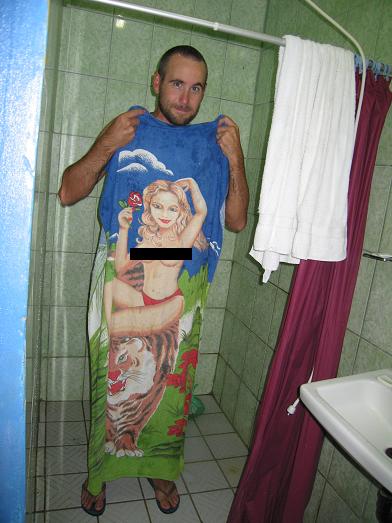
We loved the standard Nicaraguan meal of comida corriente, which was usually rice, beans, tortillas, salad, and something else like huevos rancheros. The sweet part is that the number of tortillas provided is increasing.
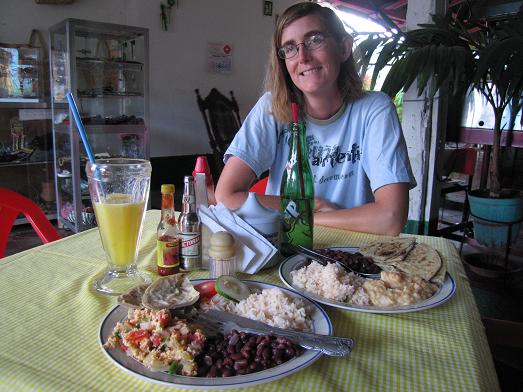
There are lots of trails on Ometepe Island, but not all of them lead anywhere.
Spikey tree on Ometepe Island. We didn’t hug this one.

Camo moth trying to look like bark.

Howler monkey checking us out.
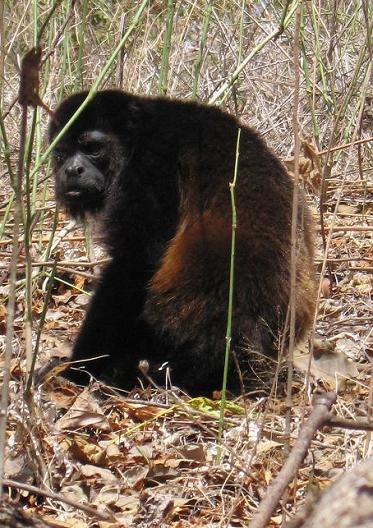
When we left Ometepe, we took a cab from the pier to the bus station. The whole time the cabbie was telling us that the next bus left in 3 hours but he would be happy to drive us to Granada for $30. Having heard this kind of crap before, we insisted on going to the station. And, of course, there was a bus leaving in 20 minutes that cost about $1.50.
Granada is a very cute, colorful, colonial town. Not much of the original colonial architecture is left since the American William Walker burned the city down (he was a nutter who tried to take over Central America in the mid-1800s). Granada is getting ready to be a serious tourist destination. Lots of construction and painting going on. Equally important, they have excellent coffee bars already.
Granada’s central park and cathedral. Nice place to relax.
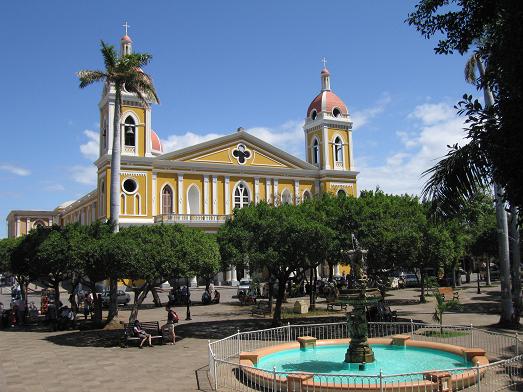
Nice bell tower at another one of Granada’s churches, the Inglesia de la Merced.

The town of Masaya is only an hour away from Granada and had a really great old market. If you’re interested in nice wood work, Nicaraguan baseball jerseys, or fake Cuban cigars, this is a must visit.
The Masaya Volcano was thought to be “the gateway to Hell” by the early Spainards and they built a big cross above it to exorcise the devil. Looking down into it’s steaming depths, we couldn’t argue with them. Those white things are buses for scale.
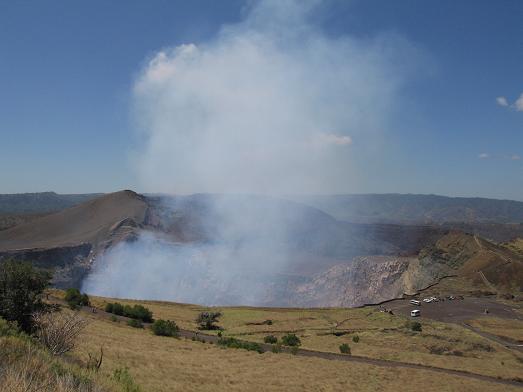
We headed to Matagalpa by way of Managua and tried to spend as little time as possible in the capitol. Managua has the reputation of being a very dangerous place and we weren’t keen to find out if that was true. It was funny then to arrive in Matagalpa (a place we thought would be safe) and see a huge sign warning tourists that they would be robbed if they got into a cab outside the bus station – complete with an image of a guy holding someone up with a gun. Thankfully, we found the town perfectly safe, but we skipped the cab ride.
Not far from Matagalpa is the private nature reserve of Selva Negra (called Black Forest by the Germans who set it up). On the way into the park we passed a bunch of folks picking coffee beans and it was good to remind us that there are hard working folks responsible for Marc’s morning latte. This park was really nice. Good hiking trails and we didn’t see another person the whole time we were there. The sweet part was that the small entry fee went towards post-hike coffee and cake in their restaurant.
The easiest critters to photograph in Selva Negra were, surprisingly, the butterflies.
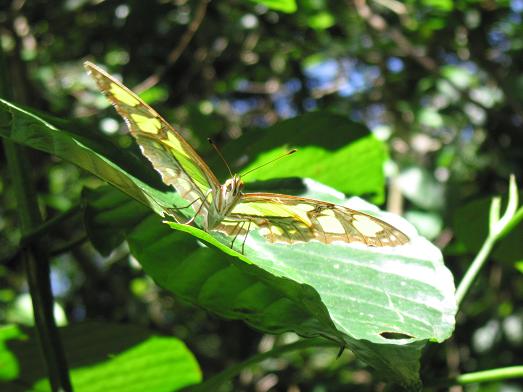
Another butterfly in Selva Negra.
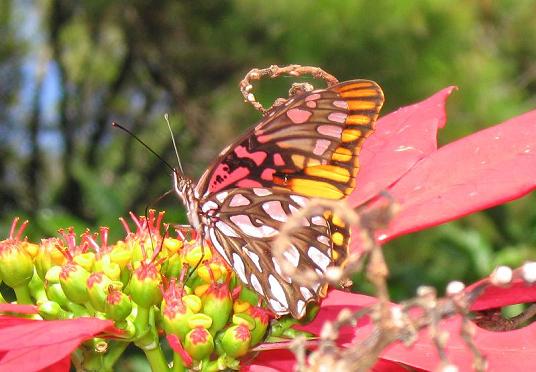
Nicaragua was the first place we’ve been to that baseball seemed to be more popular than any other sport. On one weekend bus ride, we saw a baseball game going on in every town we passed through.
There’s a lot of nickel and diming that goes on at borders. When we crossed from Nicaragua to Honduras, the immigration officials both charged fees of a couple bucks each and then didn’t even stamp our passports. Marc tried to challenge the fees requested by the Nicaraguan border official and went so far as to ask to speak with his boss. His reply: “¡Soy jefe!” (I’m the boss!). That didn’t work so well.
It takes three buses to cover the short distance from the border to the capitol of Tegucigalpa (or Tegus for short) including a change in El Paraiso – the self-proclaimed “La Ciudad de Cafe”. Marc thinks that city needs further exploration. We liked Tegus but only saw one other tourist the whole time we were there. The Hondurans were quite friendly in the capitol and there were loads of American fast food chains. We took advantage of Pizza Hut and never have we seen so many people order iced tea in one place. There is an absolutely fantastic coffee chain called Espresso Americano in Honduras. Marc took advantage of it in every city he could. Honduran coffee really is fantastic.
Inglesia los Dolores, in Tegus.
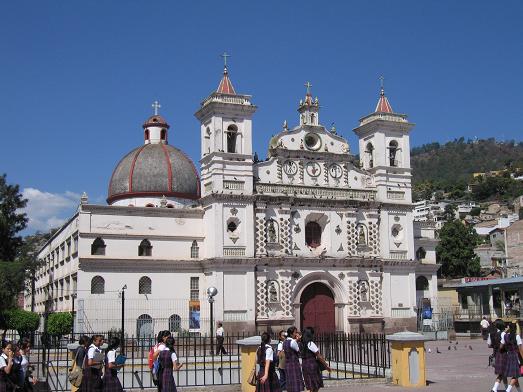
The cathedral in Tegus’ central park.
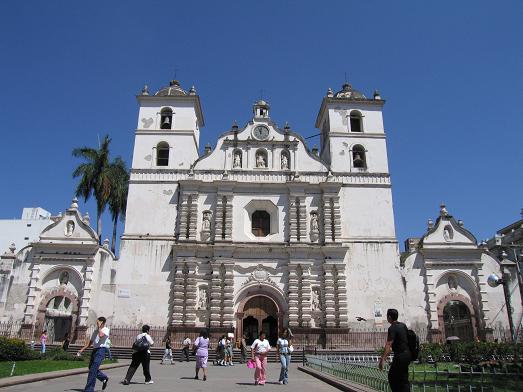
While shopping at the grocery store in Tegus, we saw they had a free sample table set up with a bunch of happy guys hanging around it. They invited us over and we found out the free sample was rum and coke! Why don’t they do that in the States? Speaking of food, they have a whole lot of fruit vendors set up on the streets in Tegus and we bought some cashew fruit.
Marc posing with the strange cashew fruit. The nut actually grows on the bottom of the fruit, not inside of it.
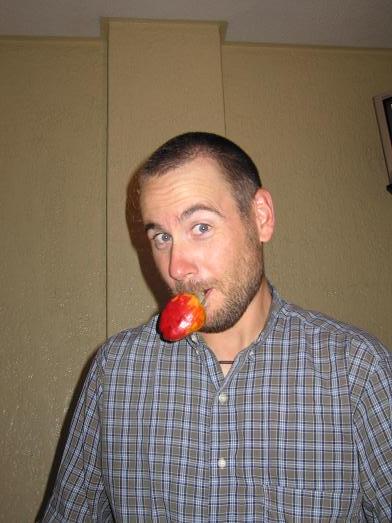
Marc didn’t respond to the fruit very well. Stunningly astringent.
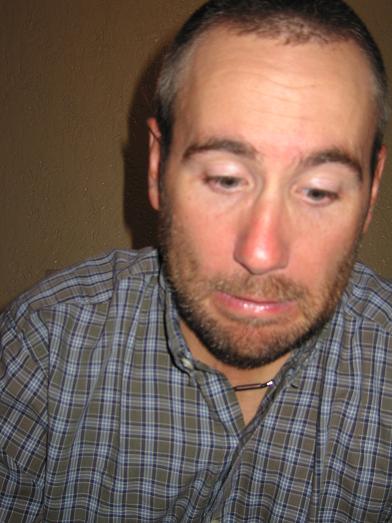
Kelly only tried one taste of the cashew fruit but Marc powered through a few slices. It was a bit of a surprise when his lips swelled up the next day and his fingers peeled. It’s not every day that you find out you have a food allergy.
We heard about a hotel/brewery run by a guy from Oregon named Bob near Lago de Yojoa. We had a hard time finding the D&D Brewery when we got near the town of Los Naranjos and it was only by asking a taxi if he knew “el gringo que hace cerveza” (the gringo that makes beer) that we found it. This place was really nice. Maybe it was all of those American touches, like screens on the windows, lightbulbs more than 10W, hot water, and non-stinky plumbing. Brewmaster Bob gave us a tour of his cargo container-turned-brewery and Marc picked up some suggestions for future beer brewing. Anyone who was subjected to his last brew (named Holmesgarten) will appreciate the need for improvement.
Us sampling mago ale and blueberry soda at the D&D Brewery.
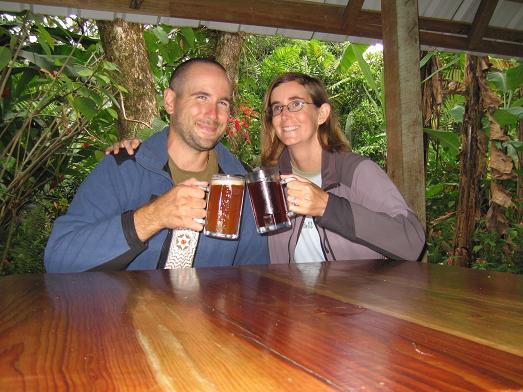
There were some nice forested areas around the D&D and we found one spot with a bunch of neat birds. The coolest were the keel-billed toucans that have incredibly colorful bills. Bob suggested that “the best 40 limps we could spend in Honduras” would be to rent a row boat and paddle around the lake. So we did, but it was a painful experience due to high winds.
Marc eyes the angry weather. Maybe we should have spent that 40 limpiras on another beer and soda…

We’ve been in a lot of internet cafes on this trip, but the place in Los Naranjos was notable. Sure, we’ve used computers in peoples’ homes before. But this one was in some teenager’s bedroom right next to his weight bench and it was packed with school kids waiting to use the few machines. Funny thing was it actually had a decent connection.
We headed to the coastal town of Tela by way of the transport hub of San Pedro Sula. As we neared San Pedro, we started paying attention to stops the guy was yelling out. We knew we wanted to get off near the central park for our onward connection. So when he yelled out “parque”, Marc asked if it was the central park and was assured that it was by both the driver and the money collector. We jumped off and realized we had no idea where we were. So after much discussion with the locals, we found that not only were we not at the central park, but we were in a town 30km south of San Pedro! Oops. Good thing the buses are frequent and cheap.
Near to Tela is the Lancetilla botanical gardens. Here’s an orchid from the gardens.

A really huge bamboo corridor at Lancetilla.
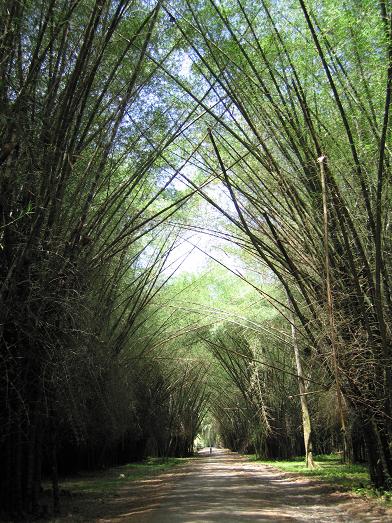
Cool mantis near the gardens.
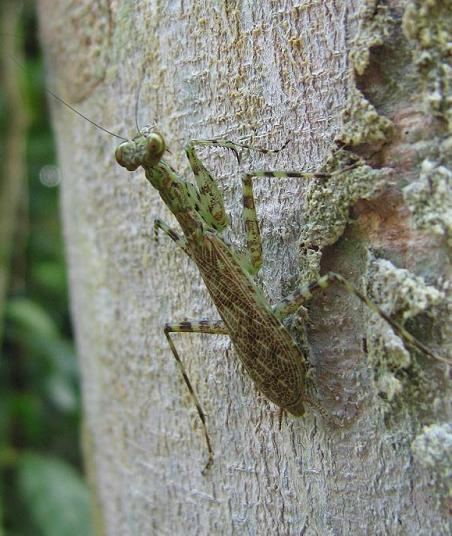
We thought we were pretty badassed when we jumped on a bus that was rolling out of Tela on its way to La Ceiba. But 45 minutes later, the driver pulled over and said the engine had died and we all had to wait for the next bus.
Yeah, we’ll admit it. We’re bug freaks! So we had to visit the Butterfly and Insect Museum in La Ceiba. It is a phenomenal collection of thousands of bugs from around the world, mostly collected by one guy. It was cool to find out that the big moth we took a picture of in Madagascar is the longest tailed moth in the world.
Marc with one of the bug museum’s hands-on exhibits.
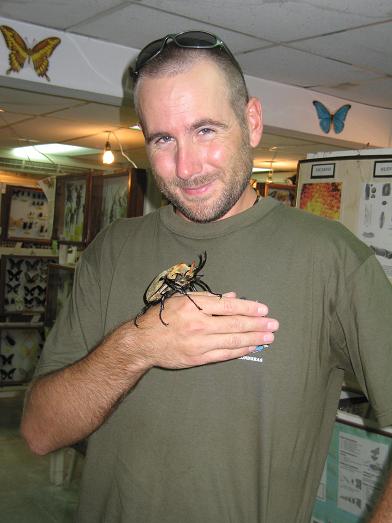
We had heard that there was fine snorkelling to be had in the Bay Islands off the Caribbean coast of Honduras. So we caught a boat out to the big island of Roatan. We still find it weird to visit these Caribbean places and hear as much English as Spanish spoken. Thanks to our Aunt Jody and Uncle Butch for giving us info on where to snorkel on the island. We ended up at a few really nice spots. In particular, the reef off of West Bay Beach was an incredible snorkelling spot with loads of shallow reef and incredible visibility. Highlights include big purple coral fans, cuttle fish, a young sea turtle, a pale spotted eel, and lots of lobsters. We stayed out in the water way too long and our scalps are still peeling.
We scored a cheap hotel in Roatan that had a shared kitchen to keep food costs down. But what was up with the pen full of deer and a sign that read “Pay per view $1”? We didn’t get it.
Palm lined beach at Half Moon bay in West End, Roatan.
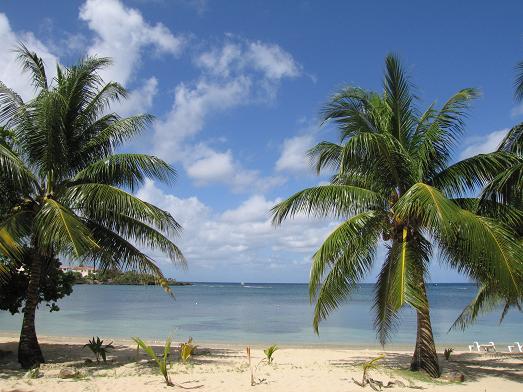
Crossing the country on a really posh bus, we headed to Copan Ruinas on the border with Guatemala. We had read that the Hondurans had a fondness for fireworks and that it could sound like the revolution had started. We were assured that we would lose sleep, and that we did.
This must be a sign that we’ve been travelling too long. At a restaurant our first night in Copan, we noticed a piece of crap on the table and we just covered it with a napkin. When a fresh piece fell from the ceiling, we just changed tables. When there was a smooshed spider on the side of Kelly’s bottle, she just wiped it off. A roach climbed across the table and Marc just brushed it off. And when another bug committed suicide into the candle, we almost didn’t notice.
The ruins at Copan was our first Mayan site of this trip. The place is notable for its sculpture and we loved the Mayan glyphs. Copan had some rulers with really neat names. Our favorites include: Smoke Monkey, Moon Jaguar, and 18 Rabbit.
Kelly with one side of the ball court topped with macaw-head statues.

One of the intricately-carved stelae at Copan.
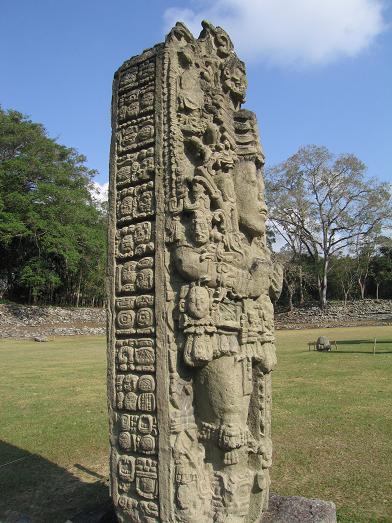
There was also a very nice museum at Copan that contained a lot of the original sculpture work. But the highlight of the museum was the full-sized reproduction of the Rosalila temple that is still burried underneath one of the large pyramids. Aparently, those bright colors are acurate.

The ruins were great, but what we enjoyed most at Copan were the semi-wild scarlet macaws that hang out at the entrance. We think the guards provide food for them, but they were free and able to go where ever they wanted – which seemed to be not far from the toilets.
Marc and two of those gorgeous macaws waiting in line for the bathrooms.

“Wait your turn buster!”

Tags: Honduras, Nicaragua

March 21st, 2007 at 5:56 pm
Estoy apesadumbrado que me olvidé de mencionar la alergia de Runyan a los anacardos de Nicauraguan. ¡Nota sin embargo nosotros no son alérgicos a esas toallas de baño dulces!
March 21st, 2007 at 7:11 pm
Oh WOW once again…. that anazing pink butterfly more than makes up for the icky yellow snake!
I’ll note the food allergy in your baby book Marc 🙂
Love you xoxo
March 22nd, 2007 at 9:12 am
I agree, the butterfly is beautiful, much nicer than that yellow snake…
March 22nd, 2007 at 9:04 pm
The naked chick on the angry tiger is so cliché…didn’t Rocky and Adrian buy matching jackets with that logo in the original Rocky?
April 2nd, 2007 at 9:05 pm
I hope you are having a great time in Mexico. I can’t wait to read what you have seen and experienced! K~